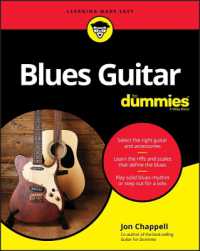- ホーム
- > 洋書
- > 英文書
- > History / American
Full Description
Land, People, Nation, Third Edition, by Anna Uhl Chamot and Kathleen Anderson Steeves, helps students build the skills they need to study history and geography. The short, engaging readings and color illustrations, maps, charts, and graphs help students build valuable interpretive skills as they master academic content and develop language proficiency. The book provides explicit instruction in learning strategies based on the CALLA model (preparation, presentation, practice, self-evaluation, and expansion). The book also serves as a valuable alternative for students experiencing difficulty with a basal American history text. Land, People, Nation includes a new section, "Be a Historian," that builds basic skills in history and geography, such as using primary and secondary resources, applying analysis skills, and using maps, globes, charts, and graphs. Each unit begins with a timeline, plus warm-up activities that encourage students to relate their background knowledge to the unit topics. Vocabulary-building exercises, learning strategies, and comprehension checks help students understand and recall what they have learned.There are also opportunities for students to research, write, and present reports on important people and events in U.S. history. "Listening" sections allow students to practice their listening and note-taking skills. "Viewing" sections enable students to visualize past and recent events more clearly. At the end of each unit, expansion activities have students think in depth about a historical topic and apply the lessons of history to their own lives. Features: *Aligned to the national history standards.*Correlations to assist in lesson planning.*Website listings to assist instructors.
Contents
To the Student Be a Historian: Building Skills in History and GeographyUsing Maps and GlobesUsing Primary and Secondary SourcesUsing Time LinesUsing Graphs and ChartsUsing ResourcesUnit 1: The Earliest Americans Reading: The First to Come to the AmericasReading: The Polar RegionsListening: The InuitReading: The Mayas, Aztecs, and IncasReading: Moctezuma Meets CortesListening: The Iroquois and the AnasaziExpansion: Foods from the AmericasUnit 2: Explorers and Explorations Listening: Why People ExploreReading: Christopher ColumbusReading: The Wet Tropical RegionsReading: EstevanWriting: Report on an Explorer of North AmericaReading: The Northern Forest RegionsExpansion: Recent ExplorersUnit 3: European Colonies in North America Reading: New SpainReading: Jamestown and Plymouth: The First Permanent English ColoniesViewing: Images of English and Spanish Colonial LifeListening: MassasoitReading: Anne Hutchinson and the PuritansWriting: Report on Anne Hutchinson's LifeReading: The Mid-Latitude Forest RegionsReading: New France and New AmsterdamReading: The Thirteen English ColoniesReading: The French and Indian WarReading: Benjamin Franklin: A Revolutionary LifeExpansion: Benjamin Franklin's InventionsUnit 4: From Colonies to Nation Reading: The Colonists Begin to ProtestReading: The War for Independence BeginsReading: The Colonies Declare IndependenceWriting: Report on the War for IndependenceReading: A Great American LeaderWriting: Report on a Revolutionary War HeroReading: The United States ConstitutionReading: The Three Branches of GovernmentReading: The Bill of Rights: Amendments 1-10Expansion: Federal and State GovernmentsUnit 5: The Nation Grows Reading: Moving WestReading: Daniel Boone: A Pathfinder to the WestReading: Land Gained by Purchase and TreatyReading: Jefferson: Writer, Thinker, PresidentListening: The Journey of Lewis and ClarkReading: The Highland RegionsListening: James Madison and the War of 1812Reading: The Monroe DoctrineReading: Settling the WestReading: The Mediterranean RegionsReading: Andrew Jackson: A Controversial LeaderReading: Native Americans Lose Their HomelandsWriting: Report on a Native American LeaderReading: At War with MexicoTime Line: Presidents from 1797 to 1850Expansion: The Impact of InventionsUnit 6: The Civil War and Reconstruction Reading: The South and the NorthReading: Slaves and SlaveryReading: Free States and Slave StatesReading: Harriet Tubman and the Underground RailroadReading: John Brown: A Famous AbolitionistWriting: Report on John Brown Reading: The Nation Falls ApartReading: A Nation DividedListening: Abraham Lincoln: A Leader in Difficult TimesWriting: Report on a Nineteenth-Century American Reading: Putting the Nation Back TogetherReading: The Lives of Free BlacksReading: Three Important African-American Leaders in the Civil War EraTime Line: Presidents from 1850 to 1875Expansion: U.S. Decisions about WarUnit 7: Industrialization and Change Reading: The United States, 1865-1900Reading: What Was the Industrial Revolution?Reading: Life after the Industrial RevolutionReading: The Grassland RegionsReading: The CowboyReading: Treaties and TerritoriesListening: Sitting BullReading: The Desert RegionsReading: Inventions in the United States, 1834-1903 Reading: People with Ideas for ChangeReading: Women in the United StatesReading: A Nation of ImmigrantsWriting: Report on an Immigrant to the United States Time Line: Presidents from 1875 to 1900 Expansion: Obstacles Immigrants FacedUnit 8: The Early Twentieth Century Reading: A New EraReading: Workers' Power Grows Reading: New OpportunitiesReading: The Progressive MovementReading: "The War to End All Wars"Viewing: Images of World War IReading: The War ExperienceReading: The Treaty of VersaillesReading: Times of ContrastViewing: Images of the Roaring TwentiesReading: A Decade of ExcessReading: The Stock Market CrashesReading: The New DealListening: Eleanor Roosevelt: A Woman of VisionWriting: Report on an Important Twentieth-Century American Time Line: Presidents from 1900 to 1940 Expansion: Thinking Like an Historian Unit 9: World War II and the Postwar Era Reading: From Depression to WarReading: World Conflicts Lead to WarReading: Peace or War for the United States?Viewing: Images of the War Effort Listening: The Code TalkersReading: The Axis Powers Are DefeatedReading: Boom TimesReading: Prejudice Follows the Soldiers HomeReading: A New Kind of WarReading: Cold War FearsReading: Social and Technological ChangesWriting: Report on an Inventor or Scientist of the Mid-Twentieth CenturyTime Line: Presidents from 1940 to 1960Expansion: The Postwar PeriodUnit 10: Decades of Protest: The 1960s and Beyond Reading: A New FrontierReading: The Cold War IntensifiesReading: The Civil Rights MovementListening: Dr. Martin Luther King, Jr.Reading: Other Groups Struggle for EqualityReading: End of an EraReading: The United States in VietnamReading: Protecting the EnvironmentWriting: Report on a Leader Who Acted for ChangeReading: Presidents Nixon, Ford, and CarterTime Line: Presidents from 1960 to 1980Expansion: Songs of ProtestUnit 11: Entering the Twenty-First Century Reading: Jobs Change; People MoveReading: Schools Meet America's Changing NeedsListening: The Sanchez SistersReading: Environmental Concerns IncreaseReading: Inventions Change Our Lives AgainReading: Information ExplosionReading: Four Recent PresidentsViewing: Interpreting Political CartoonsReading: GlobalizationReading: September 11, 2001, and Its AftermathReading: Wars in Afghanistan, Iraq, and LebanonViewing: Images of U.S. Concerns at Home and Abroad Time Line: Presidents from 1980 to 2007Expansion: Looking Back, Looking ForwardGlossaryCreditsIndexList of Maps Highland RegionsMediterranean RegionsNative American HomelandsFree States and Slave States and Territories after the Missouri Compromise, 1821The United States after Secession, 1861The Civil War The United States in the Pacific and Latin America, 1900Grassland RegionsReservations in the West, 1890Desert RegionsWomen's Suffrage before 1920Europe in 1914Europe after World War IGerman Aggression, 1938-1941Allied Advances in the Pacific, 1941-1945Allied Advances in Europe and North Africa, 1942-1945Europe after World War IIRange of Soviet MissilesSoviet Threat and U.S. ResponseWar in Southeast Asia Central Asia: The Middle East







